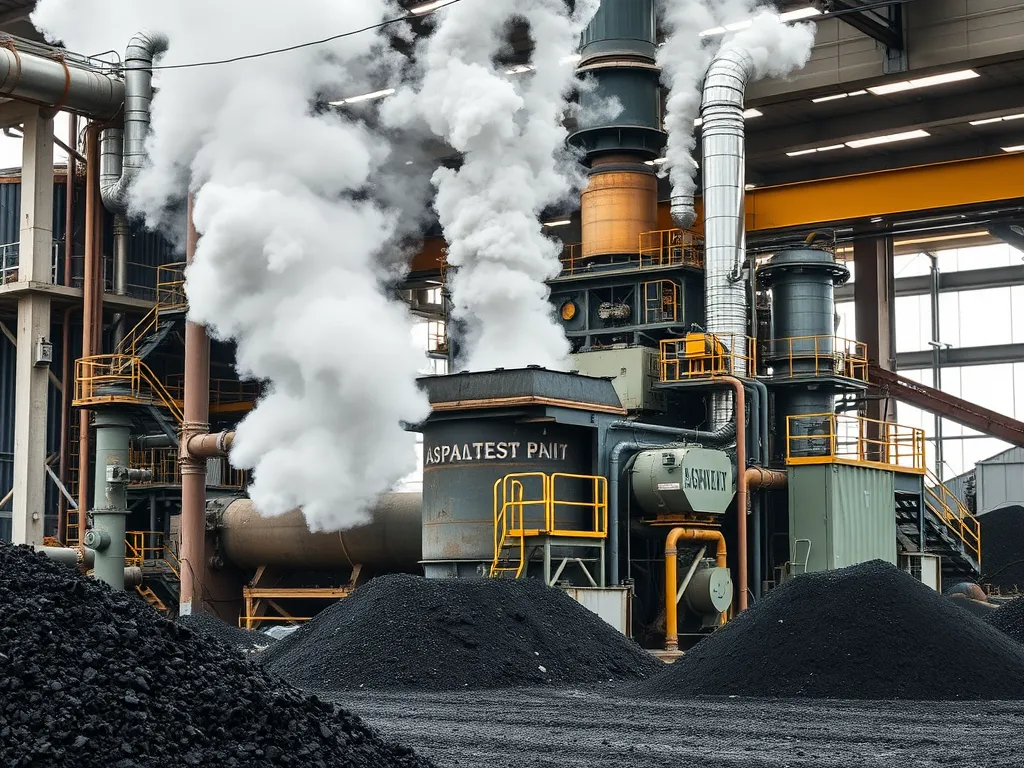Cold Patch Vs Hot Mix Patching: Key Differences, Costs &Amp; Applications
Published on: October 16, 2025 | Last Updated: April 14, 2025
Written By: George Voss
Cold patch and hot mix patching fix asphalt damage using different methods. Cold patch arrives ready-to-use without heating—perfect for emergency repairs in rain or snow. Hot mix needs heating to 300-350°F during installation, creating durable patches for busy roads. Choose based on repair urgency, traffic volume, and long-term needs.
This guide compares both methods across seven factors. Explore material costs ($2-5 per sq ft for cold patch vs $3-8 for hot mix), installation steps, and lifespan (2-5 years vs 8-15 years). Learn which solution fits pothole fixes, residential driveways, or heavy-duty commercial pavements.
Contents
- Understanding Asphalt Patching Basics
- Cold Patch Vs Hot Mix: Core Differences
- Cold Asphalt Patching: Advantages and Limitations
- Hot Mix Asphalt Patching: Strengths and Weaknesses
- Cost Analysis: Cold Patch Vs Hot Mix
- Application Techniques for Asphalt Repair
- Durability and Performance Comparison
- Environmental Considerations in Asphalt Repair
- Frequently Asked Questions (FAQs)
- Closing Thoughts
- Additional Resources for You:
Understanding Asphalt Patching Basics
Road repair demands the right materials for lasting results. Cold patch and hot mix asphalt serve distinct roles in pavement maintenance. Let’s break down their core characteristics.
What is Cold Patch Asphalt?
Cold patch offers a quick fix for damaged surfaces. This material works without heat, making it accessible for urgent repairs.
Definition and Composition
Cold asphalt patch combines aggregates (crushed stone, sand) with a modified bitumen binder. Unlike hot mix, it uses emulsified asphalt or solvents to stay workable at ambient temperatures. Common mixes contain Performance Grade (PG) 64-22 binders for moderate climates. Some formulas include recycled asphalt pavement (RAP) up to 30% for cost savings.
Primary Use Cases in Asphalt Repair
This material excels in temporary fixes and low-traffic areas. Contractors deploy cold patch for potholes on residential driveways, parking stalls, or rural roads. Its tolerance for temperatures between 20°F (-6°C) and 110°F (43°C) makes it ideal for winter emergencies when hot mix plants shut down.
What is Hot Mix Asphalt Patching?
Hot mix patching delivers permanent structural repairs. This method requires precise temperature control for optimal performance.
Definition and Production Process
Hot asphalt patching mixes heated aggregates (typically 300-350°F) with viscous PG 58-28 or PG 76-22 binders. Plants blend materials in drum mixers, achieving a homogeneous consistency. High-density mixes like Superpave 4.75 mm enhance durability for heavy traffic zones. Production costs average $70-$100 per ton, excluding delivery fees.
Typical Applications in Pavement Maintenance
State DOTs rely on hot mix for highway repairs and full-depth pavement restoration. Commercial properties use it for parking lot resurfacing and airport runways. Proper compaction at 275°F+ creates seamless bonds, preventing water infiltration. Applications require ambient temperatures above 40°F (4°C) for proper curing.
With both methods defined, let’s examine their material properties and performance under different conditions.
Cold Patch Vs Hot Mix: Core Differences
Cold patch and hot mix patching vary in how they work, last, and fit specific jobs. Knowing what splits them apart aids in picking the right fix for roads or driveways.
Material Properties Comparison
Cold asphalt patch and hot asphalt patching start with distinct formulas. Cold mix holds aggregates bound by bitumen emulsion or cutback asphalt. It stays workable at air temp. Hot mix asphalt patch blends stone, sand, and PG (Performance Graded) binders heated to 300°F+ during production.
Binding Agents and Temperature Requirements
| Factor | Cold Patch | Hot Mix |
|---|---|---|
| Binding Material | Bitumen emulsion | Petroleum-based bitumen |
| Application Temp | 40°F–100°F | 220°F–300°F |
| Curing Time | 3–7 days | 24–48 hours |
Hot mix needs high temps to activate binders, forming a tight bond. Cold asphalt vs hot asphalt relies on solvents that slowly vanish, letting the patch harden.
Performance in Different Weather Conditions
Cold patch works in rain, snow, or freezing air (as low as 40°F). Its flexibility suits shifting ground in spring thaws. But long sun exposure may soften it, causing rutting under heavy trucks. Hot mix asphalt patch demands dry, warm air (50°F+) for proper compaction. Once set, it withstands 150°F pavement temps without deforming.
Hot mix vs cold mix asphalt holds up better under constant traffic. Cold mix asphalt lasts 6–12 months; hot mix patches can go 5–8 years with good upkeep. Frost heave impacts cold patches more, while hot patching resists cracking in icy conditions.
With clarity on how cold vs hot patching works, it’s vital to weigh their strong points and weak spots for your job.

Cold Asphalt Patching: Advantages and Limitations
Cold mix asphalt provides unique benefits for specific repair scenarios but comes with trade-offs. Let’s break down its strengths and weaknesses.
Pros Of Cold Mix Asphalt
Cold patch asphalt stands out for speed and accessibility. These features make it a go-to solution for urgent repairs.
Immediate Use Without Heating
Cold asphalt patch materials work straight from the bag at ambient temperatures. No heating equipment or hot mix plants required. This cuts project start time by 80% compared to hot asphalt patching methods.
Emergency Repair Capabilities
Fix potholes in rain, snow, or freezing temps with cold mix. Hot mix asphalt patch solutions can’t be applied below 40°F. Municipal crews rely on cold patch for winter road repairs when asphalt plants shut down.
Lower Skill Requirements
Homeowners can tackle driveway repairs with basic tools. No need for rollers, hot boxes, or trained crews. A shovel, tamper, and 30 minutes often suffice for small cold asphalt patching jobs.
Cons Of Cold Mix Asphalt
Trade-offs emerge when comparing cold vs hot asphalt performance. Durability and strength top the list.
Reduced Long-Term Durability
Cold mix asphalt repairs last 6-18 months versus hot mix’s 5-10 years. The oil-based binders in cold patch degrade faster under UV exposure and traffic. High-traffic areas show raveling within weeks.
Limited Load-Bearing Capacity
Cold asphalt vs hot asphalt strength differs sharply. Cold patch handles 5,000 vehicles daily max. Hot mix asphalt patch materials withstand 20,000+ vehicles. Truck lanes and highway repairs demand hot mix’s structural integrity.
These limitations set the stage for exploring hot mix asphalt’s strengths in permanent, high-performance repairs.
Also See: Asphalt Properties and Road Safety: Key Insights
Hot Mix Asphalt Patching: Strengths and Weaknesses
Hot mix asphalt patching remains the gold standard for permanent repairs in commercial and heavy-duty applications. Produced at 300-350°F in asphalt plants, this material combines performance-grade (PG) binders with precisely graded aggregates under strict Superpave specifications. Let’s examine why professionals choose hot asphalt patching – and when alternatives might prevail.
Pros Of Hot Asphalt Patching
Hot mix outperforms cold patch asphalt in critical areas requiring structural integrity. Its high-temperature installation activates superior material properties.
Superior Bonding Quality
Freshly laid hot mix bonds seamlessly with existing pavement through thermal fusion. The 285-325°F material temperature creates molecular adhesion, achieving 90-95% density immediately after compaction.
Extended Service Life
Properly installed hot mix patches last 15-20 years versus cold asphalt’s 2-5 year lifespan. The dense-graded mix resorts to rutting, with load-bearing capacities exceeding 20,000 ESALs (Equivalent Single Axle Loads).
Professional-Grade Results
Hot mix meets ASTM D692/D692M standards for public roads and commercial lots. When compacted to 7-8% air voids, it matches original pavement’s skid resistance (SN 40-50) and impermeability.
Cons Of Hot Asphalt Patching
While hot mix asphalt patch quality is unmatched, logistical constraints limit its accessibility for smaller projects.
Weather-Dependent Application
Hot patching requires ambient temperatures above 40°F and dry conditions. Below 50°F, mix temperature drops 25°F every 2 minutes – risking incomplete compaction below 220°F.
Specialized Equipment Needs
Hot mix demands infrared heaters ($15,000-$25,000), heavy rollers ($50,000-$250,000), and haul trucks. Small batches under 5 tons become cost-prohibitive, with minimum plant orders averaging $100-$200/ton.
While hot mix asphalt patch repairs dominate high-traffic scenarios, cost and practicality factors shift the balance for temporary fixes. Next we’ll break down how material expenses and project scale influence your patching budget.

Cost Analysis: Cold Patch Vs Hot Mix
Material and labor costs separate these asphalt repair methods more than any other factor. Budget-conscious projects lean toward cold mix, while long-term investments favor hot asphalt patching.
Material and Labor Cost Breakdown
Cold patch asphalt costs $15-$30 per 50lb bag, requiring no specialized tools. A typical driveway pothole repair uses 2-3 bags ($45 max). Labor costs drop to zero for DIYers – compact with a hand tamper or car tires. Hot mix asphalt runs $45-$75 per ton (covers 10-12 square yards at 2” thickness). Professional installation adds $100-$150/hour for equipment like infrared heaters, pavers, and vibratory rollers.
- Cold mix savings: $0.30-$0.60 per pound vs $0.04-$0.07 for hot mix
- Hidden hot mix costs: Mandatory thermal insulation during transport ($25/ton surcharge)
- Time factor: Cold patch sets in 24 hours; hot mix needs 4-6 hours curing before traffic
Long-term Value Comparison
Hot mix asphalt patch jobs last 7-10 years with proper compaction – cold patch degrades in 1-3 years. A 500 sq.ft. driveway repair shows stark differences:
| Factor | Cold Patch | Hot Mix |
|---|---|---|
| Initial Cost | $225 | $1,800 |
| 10-Year Repairs | 4 cycles | 1 cycle |
| Total Cost | $900 | $1,800 |
High-traffic areas magnify hot mix’s value. Cold patch withstands 500-1,000 axle loads daily; hot mix handles 10,000+ (FHWA data). Recycled Asphalt Pavement (RAP) cuts hot mix costs by 20% when available.
While costs influence decisions, proper installation methods determine actual performance. Let’s examine how application techniques differ between temporary fixes and permanent solutions.
Application Techniques for Asphalt Repair
Proper installation methods separate cold patch vs hot mix patching in real-world scenarios. Both require distinct approaches to achieve functional repairs.
Cold Patch Installation Process
Cold asphalt patch needs no heating – just open the bag and pour. Workers compact the material at ambient temperatures using hand tools or small machinery. A standard 50lb bag covers 12 square inches at 2″ depth for potholes.
DIY-Friendly Repair Methods
Homeowners tackle driveway hot patch jobs with basic tools: shovel, tamper, and gloves. Key steps include cleaning debris, applying cold mix asphalt, and compacting in 3″ layers. No special permits or training required for repairs under 6 square feet.
Hot Mix Application Requirements
Hot asphalt patching demands precise temperature control between 275-325°F. Contractors use asphalt hot boxes to maintain workable consistency. The material must be placed within 15 minutes of leaving the plant to prevent premature cooling.
Professional Installation Protocols
Certified crews follow ASTM D6925 standards for hot mix asphalt patch installation. Steps include saw-cutting edges, applying tack coat (a sticky asphalt emulsion), and rolling with 8-ton pneumatic compactors. Infrared heaters sometimes prep surfaces in temperatures below 50°F.
The application method directly impacts how each repair holds up under traffic and weather. Next, we measure durability differences between cold vs hot patching solutions.

Durability and Performance Comparison
Choosing between cold patch and hot mix patching requires knowing how each handles wear, weight, and weather. Let’s break down their real-world performance.
Lifespan Expectations
Hot mix asphalt patching lasts 5-8 years with proper installation. Its thermal bonding creates dense layers resistant to cracking. Cold asphalt patch offers temporary fixes averaging 6-12 months before needing rework. Cold mixes rely on softer binders that degrade faster under UV exposure and oxidation.
Traffic Load Tolerance
Hot mix withstands 1,500-3,000 PSI compressive strength, making it suitable for highways and busy parking lots. Cold mix vs hot mix asphalt differs sharply here – cold patches max at 800 PSI. Heavy trucks can displace cold repairs within weeks, while hot patches handle 18-wheeler traffic without rutting.
Weather Resistance Factors
Hot asphalt patching cures at 275-325°F, creating waterproof seams that survive -40°F winters. Cold asphalt vs hot asphalt struggles below 50°F – its cutback emulsions take 3-7 days to set in cold climates. Both face summer challenges: hot mix resists softening up to 140°F pavement temps, while cold patches may bleed in extreme heat.
While performance factors weigh heavily, environmental impacts also shape repair decisions. Let’s examine how each method affects sustainability…
Environmental Considerations in Asphalt Repair
Both cold patch and hot mix patching affect ecosystems differently. Material choices impact energy use, emissions, and recycling potential. Let’s break down their green profiles.
Cold Patch Sustainability Factors
Cold asphalt patching shines in eco-friendliness. It uses Recycled Asphalt Pavement (RAP) at 95-100% rates, diverting 3.2 million tons from landfills yearly. No heating cuts fuel needs by 85% compared to hot methods. A typical 50lb bag generates 12 lbs CO2 versus 40 lbs for hot mix. Cold applications also eliminate volatile organic compound (VOC) releases common in heated asphalt production.
Hot Mix Energy Consumption
Hot asphalt patching requires heating aggregates and bitumen to 300°F, consuming 1.5 million BTU per ton. Plants burn 4-8 gallons of diesel fuel hourly, emitting 22 lbs CO2 per ton. Though energy-intensive, modern plants now blend 20-30% RAP into hot mix. New warm-mix tech lowers temps to 220°F, trimming energy use by 35% while maintaining pavement grades like PG 64-22.
These environmental impacts directly tie to long-term costs and performance – key factors we’ll analyze next.

Frequently Asked Questions (FAQs)
Is Hot Patch Asphalt Better Than Cold Patch?
Hot patch asphalt is generally considered better for permanent repairs due to its superior bonding quality and longer lifespan compared to cold patch asphalt. However, the best choice depends on the specific repair needs, traffic conditions, and environmental factors.
What’s the Price Difference Between Both Methods?
The cost of cold patch asphalt typically ranges from $2 to $5 per square foot, while hot mix asphalt costs about $3 to $8 per square foot. The specific pricing may vary based on location and availability, but cold patch is often the more budget-friendly option for immediate fixes.
When Should I Use Cold Mix Asphalt?
Cold mix asphalt is ideal for quick repairs, emergency situations, and when work must be done in cold or wet conditions. It is best suited for small potholes, residential driveways, and areas with low traffic volume.
What Are the Main Disadvantages Of Cold Mix?
The primary disadvantages of cold mix asphalt include reduced long-term durability and limited load-bearing capacity. Cold patches are more susceptible to raveling and can fail under heavy traffic within a short period, typically lasting only 6 to 12 months.
How Does Hot Mix Asphalt Perform in Winter?
Hot mix asphalt performs well in winter conditions as long as it is applied when temperatures exceed 40°F. Once set, it can resist harsh winter weather, including freezing temperatures, while maintaining its integrity and bonding strength.
Closing Thoughts
Choosing between cold patch and hot mix asphalt depends on your specific needs. Cold patch offers immediate solutions for minor repairs and emergencies, making it ideal for quick fixes. Its ease of use allows even DIYers to tackle simple jobs. However, its long-term durability is often a concern.
On the other hand, hot mix patches provide superior bonding and longevity, suitable for extensive pavement repairs. These require specialized equipment and are best applied in favorable weather, which can pose constraints.
Consider factors like repair urgency, traffic volume, and weather conditions when deciding. Both options have their unique advantages, so weigh your project’s specifics. For more information on optimizing your asphalt repair choices, visit Asphalt Calculator USA.
Additional Resources for You:
- Yoder, E. J., & Witczak, M. W. (1975). Principles of Pavement Design (2nd ed.). New York, NY: Wiley.
- Is Cold Patch or Hot Mix Asphalt Better for Pothole Repair? | Lakeridge Paving
- Cold Asphalt Patch vs. Hot Asphalt Patch – Riley’s Asphalt
- Hot Mix Vs. Cold Mix Asphalt: What’s The Difference?
- Hot Mix Asphalt Vs. Cold Patch Asphalt | EastCoat Pavement Services


